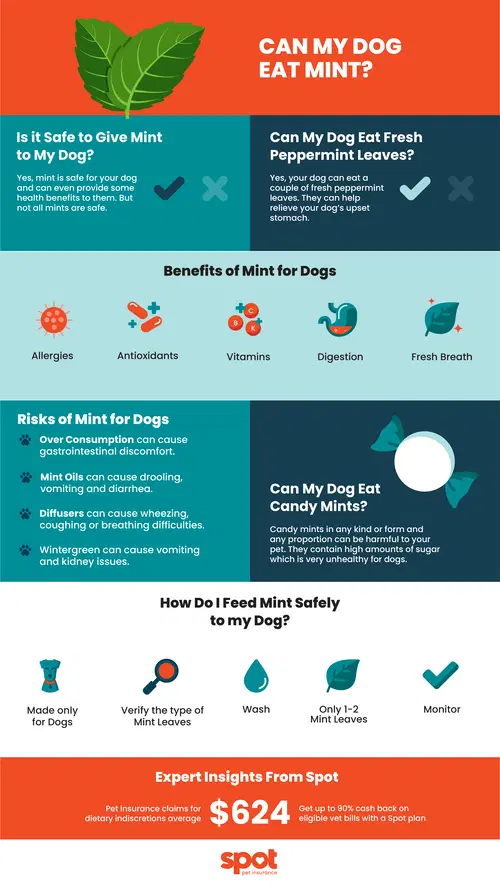Benefits of Mint for Dogs
The benefits of mint for dogs may not be the same as those for us humans. But there are still plenty of other benefits that our four-legged buddies can derive from this plant.1
Anti-oxidants – Mint is anti-oxidant rich and can help protect your dog against cell oxidation and free radical damage that contribute to cancer.
Vitamins – Vitamins A and C found in mint can help support healthy bones, skin, and vision as well as immunity.
Allergies – The rosmarinic acid found in them has been shown to relieve symptoms associated with seasonal allergies in dogs.
Fresh breath – One of the biggest benefits that humans can derive from it is applicable for dogs too. The antiviral, antimicrobial, antibacterial, and antifungal benefits can all help freshen your dog’s breath.
If mint leaves are so good for dogs, we should be feeding them to our canine pets day-in and day-out, right? Wrong. There are some risks associated with feeding mint leaves to dogs.
Risks of Mint for Dogs
There are some potential risks of feeding mint to your dog:1
Gastrointestinal discomfort – Overconsumption of any kind of mint can cause problems in the stomach leading to vomiting and diarrhea.
Mint oils – Essential oils made up of mint can be extremely toxic for your dog. Even topical application can be risky as it stands a chance of ingestion due to licking. It can cause excessive drooling, vomiting and diarrhea. In severe cases, it can even cause seizures and liver failure.
Diffusers – Mint-flavored aroma diffusers are often used in aroma therapy for humans. But these are not safe for dogs. They disperse fine particles of oil into the air. Over-inhalation of these can cause wheezing, coughing or breathing difficulties, particularly if they have asthma.
Wintergreen – Often marketed as mint, it is actually not one and is toxic to dogs. It contains an aspirin-like chemical called methyl salicylate that can cause problems ranging from vomiting and confusion to kidney issues and liver failure in dogs.
Expert Insights From Spot
While sharing our favorite foods with our pets can be tempting, it's important to remember that not all human foods are safe for our dogs. Spot's internal data shows that pet insurance claims for dietary indiscretions average $642*, highlighting the importance of caution and research before sharing snacks with your pet.
How Do I Feed Mint Safely To My Dog?
Made for dogs - Choose mint products made only for dogs. Avoid giving them any kind of human mints like candies and cookies.
Verify – Wherever you’re buying your mint from, ensure that your chosen mint plant is neither the English pennyroyal nor a wintergreen plant mistaken for mint.
Wash – Wash the mint leaves thoroughly before feeding them directly to your dog to help avoid ingestion of any kind of pesticide.
Moderation – Feed only 1-2 verified mint leaves occasionally to help avoid stomach distress.
Monitor – While introducing any new food to your dog, make sure you monitor them for any signs of discomfort.
The easiest way to add mint to your dog’s diet is to sprinkle a little fresh or dried mint over his food. Remember not to overdo it though.

Can My Dog Eat Candy Mints?
Candy mints in any kind or form and any proportion can be harmful to your pet. They contain high amounts of sugar which is very unhealthy for dogs. And if you’re thinking of sugar-free ones, there are not any better ones. They contain artificial sweeteners which aren’t good for your dog and could even put their life in danger. Xylitol, one of the most common artificial sweeteners, is highly toxic to dogs and eating a small amount can cause liver failure and may prove lethal. The peppermint oil in these candies is also toxic to your dog and can cause gastrointestinal distress.2
Can My Dog Eat Fresh Peppermint Leaves?
Yes, your dog can generally eat a couple of fresh peppermint leaves. They can help relieve your dog’s upset stomach. Dried leaves are stronger than the fresh ones. They can even be used to help cure car sickness for your dog. Having said that, do not try to feed peppermint-flavored candies or sweets to your dog. The artificial sweeteners can be very harmful to your dog. They can also choke on the candy resulting in intestinal blockage. Peppermint extracts are also not recommended for dogs. The concentration level can be very high and cause an upset stomach.
My Dog Ate a Peppermint - What Do I Do?
If your dog ends up ingesting a peppermint candy, unless they show signs of discomfort, they should be okay given the quantity is not much. But if the candy was a sugar-free one, it may require immediate action. The Xylitol in them can cause a toxic injury to your dog's liver.2 It is best to keep all kinds of candies made for humans away from them.
FAQs
Are mint leaves safe for dogs?
Yes, you can typically feed 1-2 mint leaves per day to your dog. Do not feed them more than that as it can cause some gastrointestinal problems if fed in excess.
Can dogs eat mint leaves for bad breath?
The antiviral, antimicrobial, antibacterial, and antifungal properties of mint leaves make it a natural breath freshener. You can either feed 1-2 leaves directly to them or garnish their meals with them.

The resident animal enthusiast at Spot. I have a lifetime of pet parent experience. If it has fur, feathers, or scales, I’ve probably shared my home with it. I aim to be a reliable source, blending experience with a dedication to the well-being of pets.
*Jan 2019 to Aug 2024 administrator claims data.
"Can Dogs Eat Mint? Benefits and Risks," MasterClass, 24 Mar. 2022, https://www.masterclass.com/articles/can-dogs-eat-mint.
"Can My Dog Eat Peppermint?" The Dog People by Rover, n.d., https://www.rover.com/blog/can-dog-eat-peppermint/.
The information presented in this article is for educational and informational purposes only and does not constitute or substitute for the advice of your veterinarian.












